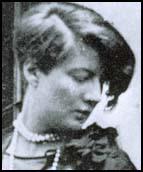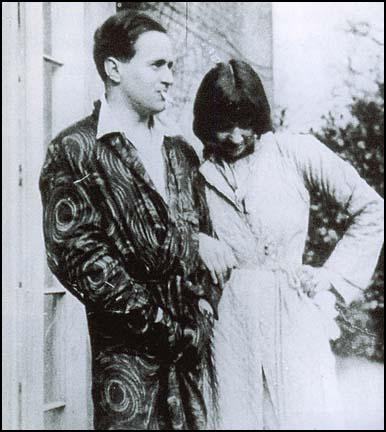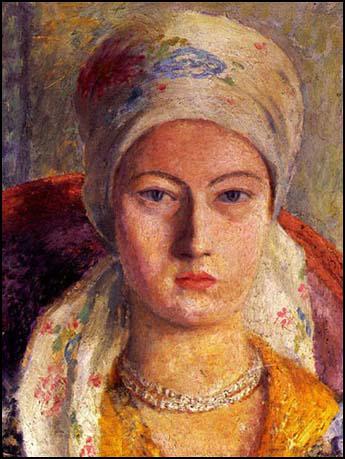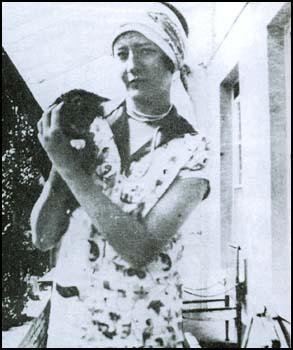Julia Strachey

Julia's uncle was Lytton Strachey and she was a regular visitor to his home Ham Spray House in Ham, Wiltshire. She became a close friend of Dora Carrington, who lived with Lytton. Julia later recalled: "From a distance she (Carrington) looked a young creature, innocent and a little awkward, dressed in very odd frocks such as one would see in some quaint picture-book; but if one came closer and talked to her, one soon saw age scored around her eyes - and something, surely, a bit worse than that - a sort of illness, bodily or mental. She had darkly bruised, hallowed, almost battered sockets."
Lytton Strachey's house became a meeting place for a group of intellectuals described as the Bloomsbury Group. Members included Virginia Woolf, Vanessa Bell, Clive Bell, John Maynard Keynes, David Garnett, E. M. Forster, Duncan Grant, Gerald Brenan, Ralph Partridge, Vita Sackville-West, Bertram Russell, Leonard Woolf, Desmond MacCarthy and Arthur Waley. She became especially close to Russell's wife Alys Pearsall Smith.
Dora Carrington loved Julia's company at Ham Spray House. She told Gerald Brenan in December 1926 : "I love having Julia here. She is a gay sympathetic character." Another regular visitor was the artist Stephen Tomlin. The biographer, Michael Holroyd, the author of Lytton Strachey (1994), has argued: "Tomlin, being bisexual, for a brief spell occupied a virtuoso position in the Ham Spray régime... The mercurial Stephen Tomlin who, greatly attracting Lytton and repelling Ralph, spiralled round the Ham Spray molecule causing shock waves everywhere." Tomlin began an affair with Henrietta Bingham, Carrington's lover. In July 1924 he took Bingham to Scotland. Carrington wrote to Gerald Brenan complaining that "Henrietta repays my affections almost as negatively as you find I do yours."

Tomlin also had sexual relationships with Julia Strachey and Dora Carrington. Carrington's husband, Ralph Partridge, strongly objected to the relationship, "fearing he (Tomlin) was someone more likely to destroy than to create happiness." Frances Marshall agreed: "One side of his character was creatively gifted, charming and sensitive; the other was dominated by a destructive impulse (fuelled probably by deep neurotic despair) whose effect was that he couldn't see two people happy together without being impelled to intervene and take one away, leaving the other bereft. Or it would take the form of a direct bid for power over others - whether male or female, for he was bi-sexual - which he was well-equipped to exert. The sequel would be a fit of suicidal depression and guilt-feelings."
Julia Strachey married Stephen Tomlin in July 1927. The married couple rented a stone cottage at Swallowcliffe in Wiltshire. Carrington was a regular visitor: "Really its equal to Ham Spray in elegance and comfort, only cleaner and tidier." Carrington was in love with both Stephen and Julia. She told Gerald Brenan that she was strongly attracted to Julia and that she was "sleeping night after night in my house, and there's nothing to be done, but to admire her from a distance, and steal distracted kisses under cover of saying goodnight." In October 1929 she sent a letter to her complaining: "Julia, I wish I was a young man and not a hybrid monster, so that I could please you a little in some way, with my affection. You know you move me strangely. I remember for some reasons every thing you say and do, you charm me so much."

Lytton Strachey died of undiagnosed stomach cancer on 21st January 1932. His death made Dora Carrington suicidal. She wrote a passage from David Hume in her diary: "A man who retires from life does no harm to society. He only ceases to do good. I am not obliged to do a small good to society at the expense of a great harm to myself. Why then should I prolong a miserable existence... I believe that no man ever threw away life, while it was worth keeping."
According to Michael Holroyd, the author of Lytton Strachey (1994): "Of all the friends he (Ralph Patridge) invited to Ham Spray it was Stephen Tomlin who appeared most successful in halting her from making another attempt at suicide." Dora Carrington wrote in her journal: "He (Tomlin) persuaded me that after a serious operation or fever, a man's mind would not be in a good state to decide on such an important step. I agreed - so I will defer my decision for a month or two until the result of the operation is less acute." After he returned home, Carrington wrote to him: "You made this last week bearable which nobody else could have done. Those endless conversations were not quite pointless."
Frances Marshall was with Ralph Partridge when he received a phone-call on 11th March 1932. "The telephone rang, waking us. It was Tom Francis, the gardener who came daily from Ham; he was suffering terribly from shock, but had the presence of mind to tell us exactly what had happened: Carrington had shot herself but was still alive. Ralph rang up the Hungerford doctor asking him to go out to Ham Spray immediately; then, stopping only to collect a trained nurse, and taking Bunny with us for support, we drove at breakneck speed down the Great West Road.... We found her propped on rugs on her bedroom floor; the doctor had not dared to move her, but she had touched him greatly by asking him to fortify himself with a glass of sherry. Very characteristically, she first told Ralph she longed to die, and then (seeing his agony of mind) that she would do her best to get well. She died that same afternoon."

Virginia Woolf and Leonard Woolf established the Hogarth Press. Over the next few years they published the work of Virginia, Flora Mayor, Katherine Mansfield, E. M. Forster, John Maynard Keynes, Robert Graves, T. S. Eliot and Edith Sitwell. In 1932 they published Julia Strachey's Cheerful Weather for the Wedding. Virginia Woolf's biographer, Hermione Lee, has argued that the novel was "an eccentric and witty story of a single difficult day at a wedding in Dorset, shows us what Virginia Woolf's tastes were in contemporary women's fiction."
Julia Strachey separated from Stephen Tomlin in 1934. During this period, Julia made a living by writing short stories for magazines. In 1939 Julia Strachey began a relationship with the artist, Lawrence Gowing, who was seventeen years her junior. Gowing, who was a conscientious objector during the Second World War, married Julia in 1954.
Julia Strachey died in 1979.
Primary Sources
(1) Francis Partridge, Memories (1981)
I greatly looked forward to my days with Julia. It was a new experience to have a boon companion so imaginative and amusing, and with whom I could talk about anything at all. If the weather was too bad for climbing trees we could always spend the whole day in the hayloft over the stables immersed in the strong effluvium of horses and harness. Here at last was someone with whom I could thrash out all sorts of problems, such as what happened after death, the existence of God, suicide and even Free Will, but first and foremost about the arch-mystery of sex. We were almost as interested in the psychological as in the physical aspect, and one thing I remember puzzling about was in what framework of words a proposal of marriage really took place. As for the physical facts, we ploughed with unflagging eagerness through dictionaries and medical books, and the pages of trashy novels such as were read in the kitchen and kept in a drawer with the dishcloths and wooden spoons. All in vain. There was on my mother's bookshelf, very likely left there on purpose, a small green book called How we are Born, and this we read from cover to cover, discussion and textual criticism following. It was as good as its word, and the function of child-bearing did begin to take grisly shape in our understandings - but strange to say, this unhelpful little manual gave no clue at all to the masculine part in the business.
As we clambered among the logs in the woodshed Julia and I used to speculate as to what it could possibly be that married people did together in order to produce a child. We had no glimmering that there could be any other purpose or pleasure involved, nor yet that it was ever performed by people who were not married.
(2) Michael Holroyd, Lytton Strachey (1994)
It had been decided, in the event of a crisis occurring, to send for another of Carrington's lovers, Stephen Tomlin. This was Ralph's idea; he wanted to mobilize anyone who might help to ensure her safety. They had got in touch with him and he was standing by. While Tommy was in the house, it was felt, Carrington would not attempt to take her own life. It was a cruel but clever expedient, for its success depended upon Tommy being so unbalanced and neurotic, so prone himself to suicide, shattered by his brother Garrow having been killed flying only the previous month, by the failure of his marriage to Julia Strachey and by all the supports in his life tottering, that Carrington's sense of responsibility would be aroused, and she would pull herself together to attend to him. Tommy's principal relations with other people contained a strong element of dependence. Lytton was not merely one of his closest friends; he relied, in some almost filial way, upon his existence. In the event of Lytton's death, Carrington would have to control herself and Tommy.
(3) Francis Partridge, Memories (1981)
Returning we saw Lytton and Carrington on the lawn. Tea was ready. ... Now it was over and Tommy (Stephen Tomlin) was standing with his back to the fireplace talking to Julia and me. He couldn't fail to be aware that Lytton was putting on his outdoor shoes, in obvious hope of a walk with him. This he does in a way all his own. He puts each shoe down with great care just in front of the foot to which it belongs, and then slips it gently in, obviously enjoying the process. Tommy was manifesting his inveterate passion for being in demand by more than one person at once, and I remembered that Ralph told me how Lytton had confessed to having put a love letter under what he believed to be Tommy's door. But not till Julia had left the room did Lytton say in a peculiarly mild voice, "Do you feel like a little walk?" They set off, and as Ralph and Carrington were driving Alix home, Julia and I were left alone together, discussing whether she would look for a job or not. She was nowhere nearer a decision.
"Swallowcliffe is definitely impossible unless Tommy and I are married - but I shouldn't be surprised if we do get married." "No. Nor should I," I said somewhat untruthfully. I don't believe she is really in love with Tommy, but it might rescue her from what she fears may be an unhappy future, and so make her happier. If only Tommy weren't so neurotic and alarmingly destructive, but of course he's extremely intelligent, and this weekend he has been sane and charming.
